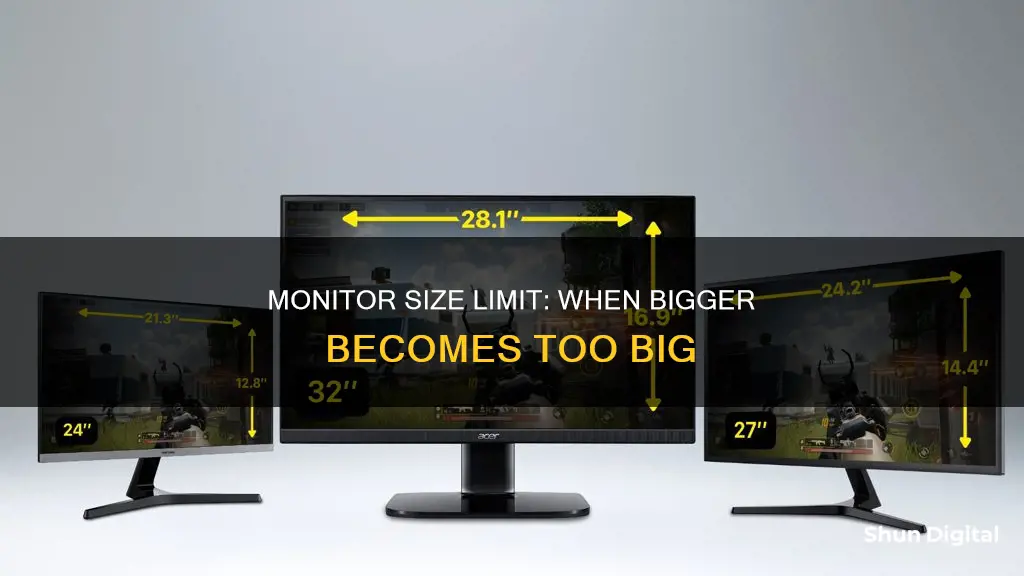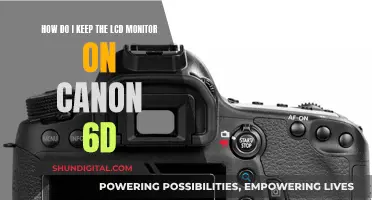
The size of a monitor can be too big, depending on the user's needs and the space available. For example, a 49-inch monitor may be too big for someone who is not a gamer and instead needs it for business applications. Similarly, a 32-inch monitor might be too large for a desk setup if the user is sitting less than two feet away from the screen. The ideal monitor size depends on various factors, including the user's distance from the screen, the type of activities they engage in, and their personal preferences.
| Characteristics | Values |
|---|---|
| Minimum viewing distance for a 32-inch monitor | 2-3 feet |
| Viewing distance for a 27-inch monitor | Arm's reach (32 inches) |
| Viewing distance for a 49-inch monitor | Not stated |
| Ideal viewing distance | Not stated |
| Viewing distance for a 1080p/75Hz monitor | 2 feet |
| Viewing distance for a 43-inch 4K monitor | 2-3 feet |
| Viewing distance for a 28-inch 4K monitor | Not stated |
What You'll Learn

Ultrawide monitors can be too wide for business use
When it comes to monitors, bigger isn't always better. Ultrawide monitors can be too wide for business use, and there are several factors to consider when making a decision.
Firstly, let's talk about desk space. Ultrawide monitors can take up a significant amount of desk real estate, and if your desk is too narrow, it may not be able to accommodate a large screen. It's important to measure your desk and the monitor you're considering to ensure a proper fit.
Another consideration is the distance between the user and the monitor. If you sit too close to an ultrawide monitor, you may find yourself straining to see UI elements at the edges of the screen. This can lead to squinting and moving windows to the middle of the screen for better visibility. Additionally, having such a large, bright light in front of you can cause headaches after prolonged use.
The intended use of the monitor is also crucial. Ultrawide monitors shine when it comes to multitasking and having multiple windows open side by side. They are ideal for professionals who work with complex interfaces, large amounts of data, and big workspaces. Developers, videographers, graphic designers, and 3D modellers can benefit from the extra screen space. However, if you primarily work within a single app and don't take full advantage of the horizontal space, a high-quality 16:9 monitor may be a better investment.
It's worth noting that not all laptops or computers can output a high enough resolution to make the most of an ultrawide monitor. Before purchasing, ensure that your device can handle the increased resolution and that you have the necessary ports for connectivity.
While ultrawide monitors offer an immersive experience and enhanced productivity for certain use cases, they may not be necessary for everyone. Consider your specific needs and budget before making a decision.
Monitoring SSRS Report Usage: Strategies for Performance Analysis
You may want to see also

A 32 monitor may be too big for a desk
A 32-inch monitor may be too big for a desk, depending on the user's needs and preferences. While some people find this size monitor ideal for their setup, others may find it too large and cumbersome.
One important factor to consider is the viewing distance. If the user is sitting very close to the monitor, around 2-3 feet away, a 32-inch monitor may be too big and could cause discomfort or strain on the eyes. Some users have reported that they need to move their heads to see the entire screen, and that the large size can cause headaches.
The type of use is also significant. For gaming, a 32-inch monitor may be too big, especially if the user is sitting close to the screen. Parts of the user interface may be in the player's peripheral vision, requiring them to move their head to see everything. Additionally, text and UI scaling can be an issue, with some games not designed to run at high resolutions, resulting in tiny menus and HUD elements.
However, for other uses, such as video editing, illustration, or movie-watching, a 32-inch monitor can be beneficial, providing more screen real estate and a more immersive experience.
Ultimately, the decision of whether a 32-inch monitor is too big depends on individual preferences and the specific use case. Some users may prefer a smaller size, such as 27 or 28 inches, for gaming, while others may find the larger size ideal for their needs.
Disabling Motion Blur on ASUS Monitors: A Simple Guide
You may want to see also

A 49 monitor may be too big for non-gamers
A 49-inch monitor may be too big for non-gamers. While it is an excellent product, it may not be the right display for non-gaming use. The Samsung CHG90 monitor is a curved ultra-wide display that measures 48.9 inches diagonally, which is almost exactly the area you would see with two 27-inch monitors. The ultrawide display works great in a variety of games, but for business use, it may be too wide. In a word-processing document or a web page, expanding a window makes it full screen, which is too wide for these applications.
However, there are some applications where the monitor is particularly useful. In a spreadsheet, you can see an amazing number of columns, and it can also be useful in some video editing situations, such as trying to assemble a lot of different clips.
For non-gaming use, a 49-inch monitor may be too big, but it can be useful for multitasking. For example, having three or four things open at once, or seeing several columns and rows simultaneously in Excel.
Debezeling Your ASUS Monitor: A Step-by-Step Guide
You may want to see also

A 32 monitor may require too much head movement
A 32-inch monitor may be too big if you are sitting too close to it. If the monitor is too close, you will have to move your head to see the entire screen, instead of just moving your eyes. One user on Overclockers UK Forums said that when they used a 27-inch monitor, they found that arm's reach (around 32 inches with shoulders square to the monitor) was the minimum distance to view the whole screen without moving their head.
Another user on the same forum said that they had a 32-inch monitor and wished for a bigger one, but they were sitting only 2 feet away from it. They also said that they used their monitor for gaming and coding and believed that 40 inches or more would be better for immersion.
Similarly, a user on Reddit said that they had a 32-inch monitor but switched to a 27-inch one because the 32-inch monitor was too big. They said that the larger monitor required too much head movement and that they experienced headaches from having such a large, bright light in front of them, taking up a big chunk of their field of view.
However, some people on the same thread said that they had a 32-inch monitor and did not find it too big. One person even said that they had a 50-inch monitor and did not need to scale it, while another person said that they had a 40-inch monitor and found it perfect.
Therefore, it seems that whether or not a 32-inch monitor is too big depends on how close you are sitting to the screen. If you are sitting very close, you may find that a smaller monitor is more comfortable and requires less head movement.
Monitor Smart TV Data Usage: Tips for Parents
You may want to see also

A 34 monitor may be too big for your space
A 34-inch monitor may be too big for your space. While more screen real estate generally means better productivity, bigger monitors aren't always better. There are several factors to consider when deciding if a monitor is too big for your space, including pixel density, sitting distance, desk size, and intended usage.
Pixel density, or pixels per inch (PPI), is a measure of how close individual pixels are together on a display. A higher PPI means a sharper and crisper display, even at close viewing distances. A 4K resolution on a 21-inch monitor, for example, will have a higher pixel density than the same 4K resolution on a 42-inch display. This means that the 21-inch monitor is suitable for use up close, while the 42-inch display is intended to be used at a greater distance.
Sitting distance is another important factor. As a general rule, you should sit one arm's length away from your monitor, or around 20 to 30 inches away. For larger monitors, you may need to sit even further away to avoid eye strain. Additionally, the size of your desk will also play a role in determining the ideal monitor size. Larger monitors can take up a significant amount of desk space, both in terms of horizontal and vertical space.
When it comes to a 34-inch monitor, it may be too big for your space if you have a small desk or limited room to sit back from the screen. A 34-inch monitor typically has a lower pixel density, which means it is intended to be viewed from a greater distance. If you are sitting too close to the monitor, you may experience eye strain or fatigue.
Furthermore, the intended usage of the monitor should be considered. If the monitor is primarily for gaming or entertainment, a larger screen size may be preferable to provide an immersive experience. However, if the monitor is mainly for work or tasks such as web browsing, a smaller screen size may be more suitable to avoid straining your eyes or having to sit too far back.
In summary, a 34-inch monitor may be too big for your space if you have limited desk depth, need to sit too far away to avoid eye strain, or if the intended usage does not align with the benefits of a larger screen. It's important to consider your specific needs and constraints when deciding on the ideal monitor size.
Monitoring Employee Internet Usage: Free, Easy, and Effective Ways
You may want to see also
Frequently asked questions
Yes, for the average user, a 49-inch monitor is too big. While it may be a good option for gaming, for business applications, it may not be the best choice. A dual-monitor setup with two 24-inch displays is more common and provides a similar area as a 49-inch monitor.
A 32-inch monitor is a good size for gaming, providing an immersive experience without being too large. However, some people may prefer a larger or smaller size depending on their setup and preferences.
A 32-inch monitor may be too large for a desk if you are sitting very close to it (less than two feet away). The ideal distance for a 32-inch monitor is arm's length, so if your desk setup does not allow for that, it may be too big.
When choosing a monitor size, it is important to consider not only the physical space on your desk but also the comfort of use. The monitor should not be too close to your eyes, and you should be able to view the entire screen without excessive head movement. Additionally, the size of the monitor may impact the compatibility of certain applications and the visibility of content.







